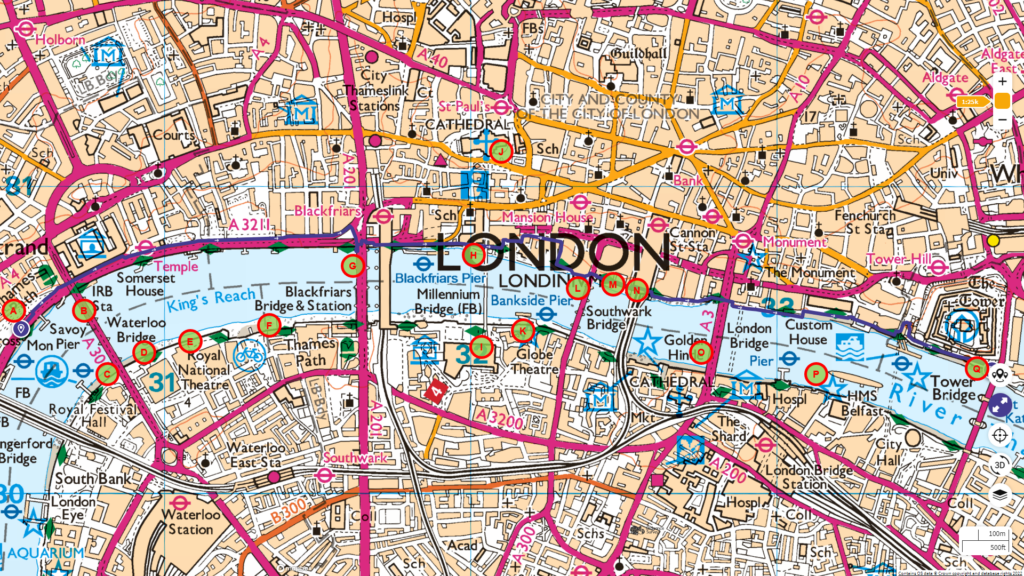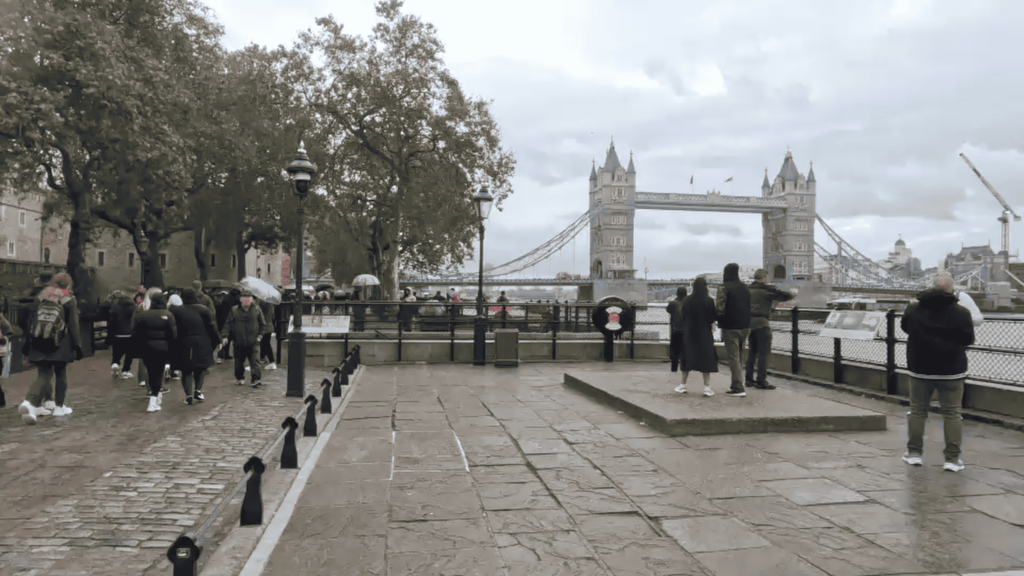The tour starts at Embankment Garden heading in a easterly direction to the City of London, concluding at Tower Hill.
Follow the entire walk on . The route map is available on

B Waterloo Bridge
C Southbank Centre (opposite bank to the right of the bridge)
D BFI Southbank (opposite end of the bridge)
E National Theatre (opposite bank)
F The OXO Tower (opposite bank)
G Blackfriars Bridge
H Millennium Bridge
I Tate Modern (across the bridge on the right)
J St Paul Cathedral
K Shakespeare’s Globe Theatre (opposite bank)
L Southwark Bridge
M Walbrook Wharf
N Cannon Street Bridge (passing under)
O London Bridge and Borough Market
P HMS Belfast
Q Tower of London
A:Victoria Embankment Garden
Victoria Embankment Garden, situated in central London, is a serene enclave amidst the city’s hustle. Originating from the mid-19th century, it emerged from the banks of a renowned river, close to a celebrated promenade. The garden features a 17th-century Watergate, initially intended for noble river access. Notable for its blend of cultural history and natural aesthetics, it hosts various significant sculptures, including tributes to a famous poet and memorials to historical conflicts. Learn More…
B: Waterloo Bridge
Waterloo Bridge, initially named Strand Bridge and later renamed in 1817, stands as a historical symbol commemorating the Battle of Waterloo. Its initial design by John Rennie, featuring nine granite arches, was lauded for its architectural elegance. The bridge has inspired numerous artists and contributed to the naming of Waterloo Station and the discovery of a unique Iron Age helmet. Reconstructed in the 1930s by Giles Gilbert Scott, the current bridge integrates parts of Rennie’s design and is recognized for its women-led construction during World War II. Waterloo Bridge, built from Portland stone, is notable for its self-cleaning properties and cultural significance in London. Learn More…
C: Southbank Centre
The Southbank Centre, positioned along the River Thames, is Europe’s largest arts center. It comprises the Royal Festival Hall, which houses the National Poetry Library, the Queen Elizabeth Hall, the Purcell Room, and the Hayward Gallery. The Centre is a hub for artistic expression, attracting over 4 million visitors annually. It’s particularly noted for the Hayward Gallery’s significant art exhibitions. Learn More…
D: BFI Southbank
The British Film Institute (BFI) Southbank is a leading cinema complex in the UK, showcasing a diverse range of films from historical classics to contemporary works. As part of the nation’s foremost film and television organization, it offers state-of-the-art screening facilities. The BFI Southbank is a key destination for film enthusiasts and professionals, hosting various screenings, events, and festivals. It features the Mediatheque for accessing British film and TV archives, and includes educational spaces, a library, and a shop, underscoring its role in promoting film culture in the UK. Learn More…
E: National Theatre
The National Theatre stands as a pivotal institution in British performing arts, encompassing three distinct auditoriums. Known for its varied repertoire that spans contemporary and classic works, the theatre is acclaimed for its high-quality productions and nurturing of new plays. Each auditorium presents a unique architectural and performance experience. Designed by Sir Denys Lasdun in a brutalist style, the National Theatre is recognized both as a cultural landmark and a center for theatrical innovation and excellence.
F: The OXO Tower
The OXO Tower Wharf, a notable structure on South Bank, is a historic landmark and a hub for design. Originally built in 1929 as an industrial building, it has been transformed since the 1990s into a space for independent artisans and design studios. These studios work with a diverse range of materials, making the OXO Tower a distinctive destination in London’s design landscape.
G: Blackfriars Bridge
Blackfriars Bridge, opened in 1864 and designed by Joseph Cubitt, was initially a railway bridge featuring significant railway insignia. Its southern insignia remains preserved and restored. After changes in the railway industry, the original bridge was removed in 1985, leaving only columns and a Grade II listed southern abutment. A second bridge, opened in 1886 and designed by John Wolfe-Barry and Henry Marc Brunel, was renamed Blackfriars Bridge in 1937. This 150-year-old bridge is currently undergoing extensive refurbishment, including painting and gilding, to preserve both its structural integrity and aesthetic appeal. The project, funded by the Bridge House Estates, includes meticulous attention to the bridge’s decorative elements, like its 1,200 balusters and aquatic bird carvings. Learn More… Additional Information…
H: Millennium Bridge
The Millennium Bridge, officially the London Millennium Footbridge, is a pedestrian steel suspension bridge spanning the River Thames. It links Bankside with the City of London, connecting St Paul’s Cathedral to the Tate Modern gallery. Initially experiencing swaying problems, earning it the nickname “wobbly” bridge, it underwent modifications and now features shock-absorbing dampers. Scheduled for a three-week closure for maintenance and deep cleaning, the bridge, maintained by the City Bridge Foundation, is a significant London landmark. Learn More…
I: Tate Modern
Tate Modern, a prominent art gallery in London, houses the United Kingdom’s national collection of international modern and contemporary art, defined as art created after 1900. It is part of the Tate group, which includes several other galleries.
J: St Paul’s Cathedral
St Paul’s Cathedral, the diocesan cathedral of London and a favorite national building, is the fifth iteration on its site. Designed by Sir Christopher Wren, it took 35 years to build (1675-1710) and stands out with its breathtaking west front, two clock towers topped with gilded copper pineapples, and a significant clock known as “Big Tom.” Inside the south-west tower are the bells “Great Paul” and “Great Tom.” The cathedral, built with Portland Stone, is a site for major state events and memorials to notable figures, including Sir Christopher Wren. It remains a functioning church with regular services. Learn More…
K: Shakespeare’s Globe Theatre
Shakespeare’s Globe Theatre originated with William Shakespeare’s acting company, The Lord Chamberlain’s Men, in 1594. Facing lease issues at The Theatre in Shoreditch, the company dismantled it and relocated across the Thames to Southwark, using the original materials to construct the new Globe Theatre. Completed in 1599, the Globe was a 20-sided structure, accommodating up to 3,000 people, and became an emblem of Elizabethan theatre. Its design included Italian marble-like pillars and a midnight blue sky, embodying the motto ‘all the world’s a playhouse’. Learn More…L:
L: Southwark Bridge
Southwark Bridge, opened in 1819 and designed by John Rennie, was an engineering feat with the largest cast-iron span of its time. Despite its remarkable construction, it was not a commercial success. The bridge faced financial and engineering challenges, ultimately being purchased and tolls abolished by the City of London in 1866. Traffic increased significantly after tolls were removed, but the bridge’s width and steep approaches were found inadequate, leading to its replacement in 1921. The original bridge, an engineering miracle of its time, was a testament to the advancements of the era but was replaced due to practical limitations. Learn More…
M: Walbrook Wharf
Walbrook Wharf, located near Cannon Street Station in London, serves as a waste transfer station. Owned by the City of London Corporation and operated by Cory Environmental, it plays a key role in the city’s waste management system. General waste from London is transported here, then loaded onto barges using a gantry. This waste is subsequently towed to the Belvedere Incinerator in Bexley, southeast London. The wharf’s operation contributes to reducing vehicle emissions by consolidating waste transport. Despite its practical role, Walbrook Wharf is designated as a ‘safeguarded wharf,’ ensuring its continual use as a working wharf and protecting it from non-port redevelopment. Learn More… Additional Information…
N: Cannon Street Bridge
Cannon Street Bridge, initially known as Alexandra Bridge, was designed by Sir John Hawkshaw and opened in 1866. Named after Princess Alexandra of Denmark, the bridge features five spans supported by cast iron Doric pillars. Originally incorporating two footpaths, it was widened in 1893. The bridge has undergone multiple reconstructions, with significant damage during World War II and renovations in 1982 by British Rail. Notable features include two original brick towers on the north side, housing hydraulic tanks for Cannon Street station. Learn More…
O: London Bridge and Borough Market
London Bridge has been a pivotal structure in London’s history, with several iterations since 1176. The Old London Bridge, built by Peter of Colechurch, was a stone arch bridge replacing earlier timber ones. It featured 19 pointed arches and a complex construction process. In 1209, it became a bustling commercial and residential hub. Throughout its history, the bridge witnessed significant events, including a devastating fire in 1282 and structural modifications in the 18th century. The current structure, designed by John Rennie and opened in 1831, replaced the medieval bridge, serving as a testament to London’s evolving engineering and architectural prowess. Learn More…
Borough Market is across from London Bridge. The market’s origins are intertwined with London Bridge, serving as a critical commercial hub since around 990AD. Evolving from a chaotic trading area to an organized market, it faced challenges from city authorities while providing vital goods to the city’s population. The market underwent various changes and relocations, reflecting the economic and social shifts of London. Today, Borough Market stands as a vibrant space for a diverse range of products, embodying centuries of London’s commercial history and cultural exchange.
P: HMS Belfast
HMS Belfast, a historic Royal Navy cruiser, was saved from the scrapyard by a trust led by one of her former captains, Rear-Admiral Sir Morgan Morgan-Giles. Built by Harland & Wolff in 1936 and commissioned in 1939, she played vital roles in World War II and beyond. After being damaged early in her service, HMS Belfast returned in 1942 with advanced radar systems. She protected Arctic convoys, participated in the Battle of North Cape, and supported the D-Day landings. Post-World War II, she was active in the Korean War before retiring in 1963. Today, HMS Belfast serves as a lasting vessel of her type for future generations. Learn More…
Q: Tower of London
The Tower of London, a significant royal fortress and London landmark, has served various roles: royal palace, political prison, execution site, arsenal, royal mint, menagerie, and public records office. Located on the north bank of the River Thames, it was initially constructed by William I the Conqueror after 1066. The central White Tower, built of limestone from Caen, formed the nucleus of the fortifications. Over the 12th and 13th centuries, the Tower’s defenses expanded beyond the city wall, enclosing an inner and outer ward. The Tower is historically intertwined with many significant events in British history. Learn More…

